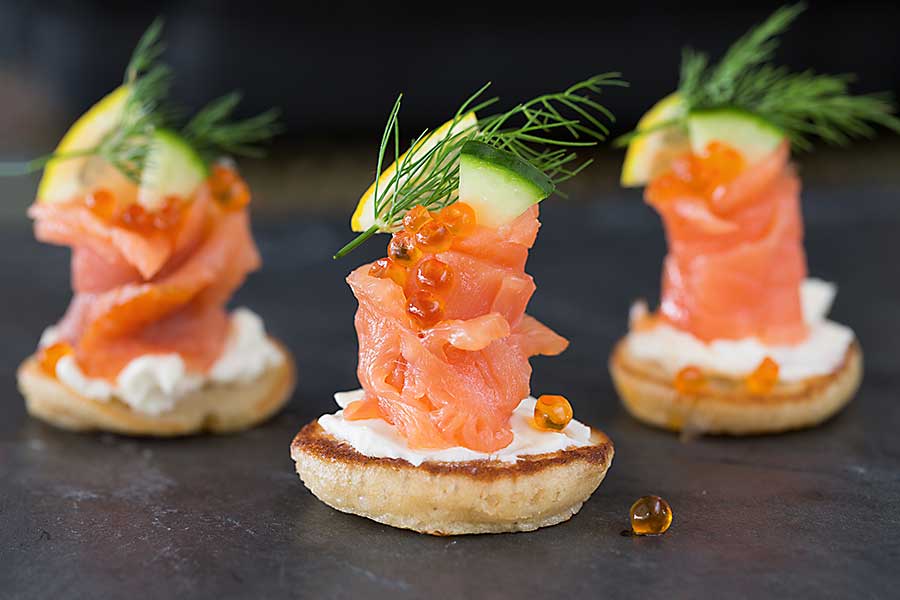Blini
Blini are a traditional dish of Russian, Ukrainian and Belorussian cuisine, and one of the most commonly eaten foods in Russia. They are a type of yeast dough pancake that is typically made from wheat or buckwheat flour. In the West, blini typically refers to a small, savoury pancake that is made with a leavened batter, usually about 5 – 10 cm long. In Russia and Ukraine, however, blinis are usually pan-sized, thinner pancakes made from unleavened batter, similar to crepes. Blini are sometimes spelled as bliny, and can be referred to as ‘blin’, as in the singular form of blini.
Due to their round shape, blini were considered to be a symbol of the sun in pre-Christian times. The East Slavic people would cook and eat blini at the end of winter, to mark the return of the sun (otherwise known as butter week or pancake week). This tradition is still practiced today.
How to make blini
Traditional Russian blini calls for a yeasted batter made with wheat. This is left to rise, then mixed with milk, soured milk or water. Both cold or boiling hot water can be used, if boiling is used it is referred to as zavarniye blini. Different recipes call for different types of flour to be used, from wheat to oatmeal to millet or buckwheat. However, wheat is the most popular type of flour used.
Also common in Russia is a thinner version of blini, prepared without yeast and with the addition of eggs and a type of fermented milk (either kefir, ryazhenka, or varenets). Traditionally, blini are baked in a Russian oven, however these days they are are more likely to be pan-fried.
Different types of blini
Blini can be prepared and served in a number of different ways, depending on the recipe used. Some variations in blini include:
- Adding ingredients to the blini batter, including apple, raisins, or even grated potato. Such types of blini are more common in Eustern Europe than in Russia,
- Blini served with butter, sour cream, fruit preserve (varenie), jam, honey, or caviar,
- Blini folded or rolled into a tube, then filled with different fillings like jam, fruit, minced meat, chicken, salmon, boiled eggs, or mushrooms,
- Blini made by frying chopped vegetables and pouring the batter over them.
How to serve blini
Blinis can be served as is, or with savoury or sweet additions. Serving suggestions include boiled fish, salmon, smoked sturgeon, salted and marinated herring, fish salad, marinated mushrooms, caviar, grated cheese, sliced eggs, fish pastes, and sauces. Usually, the savoury sides will be served along with cream or melted butter. Sweet servings of blini can be prepared with jams or fruits.
It is essential that blinis are served warm and moist, as they can quickly harden and become fragile and break easily.
Blini vs Ukranian mlyntsi
In Ukraine, blini are known as mlyntsi. The dish is immensely popular in the country and has been consumed since pre-Christian times. Mlyntsi are typically served with sour cream, caviar, fruit preserve, or sweet creams. When stuffed, the pancakes are referred to as nalysnyky. There are a number of stuffings for nalysnyky depending on the region, for example, mushroom and cabbage, cottage cheese, chopped boiled eggs, green onions, minced meat, mashed beams, fruits, and raisins. When stuffed, nalysnyky can be rolled into tubes or folded into envelopes or triangles.
Blini vs blintzes
Blintzes are a similar dish to blinis that serve an important part of Jewish cuisine. Also a type of flat, thin pancake, blintzes are often rolled into cigar shapes and stuffed with fillings like cheese or fruit. Blintzes are usually fried twice, the first time to make the pancake and the second time after being stuffed and rolled. Other typical stuffings for blintzes include mashed potatoes, chocolate, mushrooms, meat, or rice.
Private Chefs, Art of Dining
CHEFIN is a private chef platform that’s reimagining social dining.
You can easily connect with 1 of our 250 private chefs and treat your guests to restaurant-quality dining experiences in the comfort of your own home, office or chosen venue. From high-end dining to quirky social food experiences, the CHEFIN platform makes it effortless for you to access gourmet food that’s worthy of a Michelin-starred establishment.
What you get:
-
- Your very own private chef who is vetted and insured,
- A customised menu for your needs,
- 24/7 concierge support,
- Complete post-dinner cleanup,
- A fun, stress-free, and unforgettably dining experience!


